Repairing cisco console ports

Consolidation effort: Repost of short page I have done back in 2003:
This describes how to repair the broken serial console ports on some Cisco routers, such as: 2500, 2600, 7200, 7500 series.
Important disclaimer: While unlikely, it could still be possible to damage your router completely by following the steps described in this page, we take no responsibility for any damage which could be possibly caused. If you feel insecure about soldering on electronic equipment, ask someone who is skilled in that to do it for you. You should also certany not perform this steps if you have a support contract with cisco since this will void your warranty.
Foreword
Our network lab consists our of 13 different devices, mainly Cisco and is used by us to simulate different network environments for our projects. Until now, when we needed the console on some devices, we just plugged the notebook or workstation's serial cable into that device. It worked well for quite some time.
Problem
The 28th of November 2003 was quite unlucky day for our lab. Within just under 2 hours console ports on 6 of our devices malfunction, to be exact we have lost console ports on:
2501 2503 2 x C7200-IO cards 2 x C7200-FE-IO cards
The malfunctions in 5 devices manifested in ability to see the output, but not type in and one console died completely.
In addition to that, one USB to Serial adapter begun to malfunction as well.
Cause
We still do not exactly know what caused this problem, we used this setup for quite a while without any problems, but we are pretty sure that our "plug-unplug console cable" game made this thing possible in the first place. Lessons learned: Use console server as much as possible, avoid plugging and unplugging serial console cables while equipment is on.
Fix
First, our searches on the net resulted in nothing, we have seen that many people had this problem before, but all of the answers where basically "RMA or buy new" advises.
Well, our machines are not under support contract, so we cannot RMA for free and repair by Cisco would have cost us more than the whole new machines off eBay. Still, even going trough eBay we where looking at 1+k USD. So we decided to try and repair the broken machines, which turned out to be really easy and we where quite surprised that no one mentioned this option yet.
The base of the problem is the broken serial console driver chip which is soldered on the motherboard of router / card, in all of our broken devices this chip was identified as ether Motorola MC145406DW or Philips MC145406D which are basically the same chip and one can be substituted by another. Replacing the chip is quite easy, even a person with little soldering skills can do that.
Replacement chips
First thing you need is are the replacement chip(s), you can ether buy them if you find a source, or you can find a donor router and get the chips from there, which was our choice. What we found out is that all 2500, 2600, 7200 (I/O Boards) and 7500 (RSP Boards) routers use those chips to drive the console and aux ports, we also think, that most probably 3600 series does as well.
In addition to that we discovered, that all "communication" serial ports with DB60 connector are equipped with TWO of those chips per port. So, wic-1t has 2 of such chips (But not WIC-2T, they use other chips), PA-4T: 8, 7500 Fast Serial IP: 16 and 2501,2502,2503,2504 routers 6 (4 for serial ports and 2 for aux and console). And last but not the least: you could sacrifice some of the router functionality like aux or serial ports and use their chips to repair console.
[01.12.2003 Update]: If you want to have lots of chips for little money, my defenate advise would be to get a CX FSIP8 Fast Serial Interface for 7500 routers from ebay, those sell for ~30$ and have 16 chips onboard.
Tools / Skills
What you will need to perform the transplantation:
- Fine tipped soldering iron
- Tweezers
- Miniature screwdriver
- Small Pliers
- Finesse in a hand and patience
Removing the donor chips (Skip this if you already have chips at hand)
The basic rules are:
- Think about ESD protection
- Do not overheat the chip
- Do not break off the chip's legs
There are many ways to remove chip, the most advanced ones where you heat up each leg and suck out / absorb the fluid tin, but it will require you to use soldering paste or tin when you resolder the chip. The plain and simple way to remove the chips is: Stick miniature screwdriver between the legs of the chip, heat up the leg just enough for the solder to become fluid and gently bend the leg on the side / up (Not too far, about as much as visible on the left chip in the first image). After you finish with all legs you should try to remove chip, if it is still stuck try to find out which legs are still soldered on and repeat the "heat up, bend" procedure.
After 1-2 chips you should be able to safely remove them within ~2 minutes per chip. After the chip is removed use Pliers / Tweezers to realign the legs into their normal position. Make sure they are in correct positions from horizontal and vertical axes.
Removing broken chips
The basic rules are:
- Think about ESD protection
- To not damage the mainboard
- Remove the correct chip
- Remember the chip alignment
First of all you need to know which chip to remove, you can find the correct one by ether following mainboard leads from the console port resistors or just taking the chip nearest to the console port.
Again, you can ether use advanced methods of removing the fluid tin by sucking out or absorbing it, or you can simply bend the chips's legs when they heat up well enough. Whatever you do, make sure that you do not damage the mainboard, do not use force to remove the chip or you might end up with damage on mainboard's leads, if you still do damage the board, do not panic, you can fix it by tracing where those leads went and replace them by thin wires (See images in next section).
[01.12.2003 Update]: Lars-Åke Domesjö send me a hint for another way to remove the chips:
Another way to loosen the chip is to put a lot of tin across all the legs of the chip, a "tinbridge", first one side and then the other of the chip then quickly back to the first side and genltly push the chip sideways with the soldering iron tip. I find this way more kind to the pc-board, safer and less damage is done. And it's quick aswell, try it ;-)
Installing working chips
The basic rules are:
- Think about ESD protection
- Do not overheat the chip
- Seat the chip correctly
First of all, make sure you seat the new chip in correct direction, same way the previous was seated. if you do forget how it was aligned, you can pretty safely align it in the same way as aux chip is, on all our devices they faced the same direction.
It would not hurt to add some very small amounts of tin to the leads on mainboard prior of seating the chip in place, just to make sure the contacts are really good.
Use tweezers to position the chip, then, while still holding the chip in its place with tweezers push gently each leg down with soldering iron, the tin on the mainboard and chip legs should connect flawlessly.
Testing
Now plug in the console cable and turn on the router, you should have working console. If you don't check following:
- That all legs of the chip are connected to the mainboard (Push them down to motherboard once more with hot soldering iron)
- That you replaced the correct chip (Not aux one)
- That your new chip is aligned correctly
Just for statistics: We successfully repaired all 6 devices, the only mistakes done where replacing wrong (aux) chip in 2503 and destroying some mainboard leads on C7200-I/O card, which we repaired by bridging with wires.
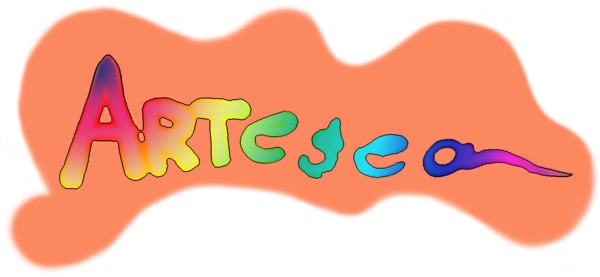

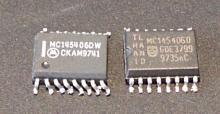
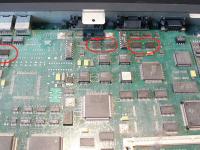
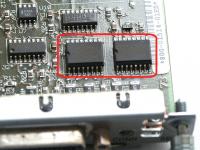
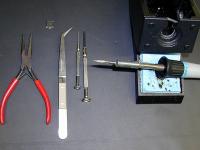
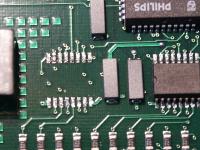
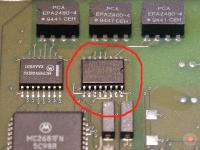
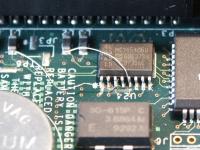
364 Comments
C
rcarwalwelregro... (not verified)
onMon, 03/28/2022 - 22:09
Permalink
C
On this platform, you can find a wide selection of casino slots
casino games (not verified)
onFri, 05/16/2025 - 21:35
Permalink
Here, you can discover a wide selection of slot machines from top providers.
Users can enjoy traditional machines as well as feature-packed games with stunning graphics and bonus rounds.
Whether you’re a beginner or a casino enthusiast, there’s something for everyone.
<a href="https://futurefly-whitetiger.com">no depisit bonus</a>
The games are available 24/7 and designed for desktop computers and smartphones alike.
You don’t need to install anything, so you can get started without hassle.
Platform layout is user-friendly, making it convenient to explore new games.
Join the fun, and dive into the thrill of casino games!
Bilinçli casino oynamak , deneyiminizi güvenceye alır .
Ernesthip (not verified)
onThu, 08/14/2025 - 07:14
Permalink
Sorumlulukla kumar oynamak , keyfinizi korur .
Oyun bütçenizi önceden belirlemek , sorunları önlemeye katkı sağlar .
Katılımınızı yönetim araçlarını kullanmak, sorunları engellemenize destek olur .
<a href="https://casinoalevtr.com/">Alev Online Casino</a>
Kumarın sorunlarının farkında olmak, uzun süreli keyif sağlar .
İhtiyaç halinde danışmanlık hizmeti danışmak, keyfi artırmaya yardımcı olur.
Bu adımlar , sorunsuz keyifli kumar deneyimi deneyimi zenginleştirir .
C
rcarwalwelregro... (not verified)
onMon, 03/28/2022 - 22:09
Permalink
C
C
rcawrlawerlegro... (not verified)
onFri, 04/01/2022 - 03:59
Permalink
C
C
rcawrlawerlegro... (not verified)
onFri, 04/01/2022 - 03:59
Permalink
C
cialis side effects in women
VeipseZes (not verified)
onWed, 08/07/2024 - 17:25
Permalink
All other adverse effects occurred with similar frequency in the 2 treatment groups, with the exception of thrombotic events; a higher incidence was seen in Tamoxifen Acdima tamoxifen citrate treated patients through 5 years, 1 <a href=https://cialis.lat/discover-the-best-prices-for-cialis>buy cialis online canadian pharmacy</a>
Мы предлагаем индивидуальные решения для вашего идеального прост
EverettIsomb (not verified)
onTue, 09/03/2024 - 06:52
Permalink
Создайте кухню своей мечты https://fabrikayfabrikaefabrika.ru/!
Скачать моды для андроид
Matthewdek (not verified)
onSat, 11/02/2024 - 22:48
Permalink
Скачать моды для андроид <a href=https://midgame.ru/>Скачать моды для андроид</a>
Скачать моды для андроид
Matthewdek (not verified)
onWed, 11/06/2024 - 09:38
Permalink
Скачать моды для андроид <a href=https://5play-mods.ru/>Скачать моды для андроид</a>
Скачать моды для андроид
MaynardPE (not verified)
onWed, 11/06/2024 - 12:14
Permalink
Скачать моды для андроид <a href=https://5modsru.ru/>Скачать моды для андроид</a>
Скачать моды для андроид
Matthewdek (not verified)
onWed, 11/06/2024 - 18:17
Permalink
Скачать моды для андроид <a href=https://modifikatsii.ru/>Скачать моды для андроид</a>
Скачать моды для андроид
Matthewdek (not verified)
onWed, 11/06/2024 - 19:56
Permalink
Скачать моды для андроид <a href=https://5mod-vzlom.ru/>Скачать моды для андроид</a>
Скачать моды для андроид
Matthewdek (not verified)
onWed, 11/06/2024 - 20:27
Permalink
Скачать моды для андроид <a href=https://5play-mods.ru/>Скачать моды для андроид</a>
Скачать моды для андроид
Matthewdek (not verified)
onWed, 11/06/2024 - 20:58
Permalink
Скачать моды для андроид <a href=https://androeedsd.ru/>Скачать моды для андроид</a>
Скачать моды для андроид
Matthewdek (not verified)
onWed, 11/06/2024 - 21:30
Permalink
Скачать моды для андроид <a href=https://androeed-top.ru/>Скачать моды для андроид</a>
Скачать моды для андроид
Matthewdek (not verified)
onThu, 11/07/2024 - 02:34
Permalink
Скачать моды для андроид <a href=https://androeedsd.ru/>Скачать моды для андроид</a>
Скачать моды для андроид
VYGeorge (not verified)
onThu, 11/07/2024 - 03:06
Permalink
Скачать моды для андроид <a href=https://dwapk.ru/>Скачать моды для андроид</a>
Скачать моды для андроид
MaynardPE (not verified)
onThu, 11/07/2024 - 03:40
Permalink
Скачать моды для андроид <a href=https://5modsru.ru/>Скачать моды для андроид</a>
Скачать моды для андроид
Matthewdek (not verified)
onThu, 11/07/2024 - 04:13
Permalink
Скачать моды для андроид <a href=https://5mod-vzlom.ru/>Скачать моды для андроид</a>
Скачать моды для андроид
Matthewdek (not verified)
onThu, 11/07/2024 - 04:44
Permalink
Скачать моды для андроид <a href=https://5play-mods.ru/>Скачать моды для андроид</a>
Скачать моды для андроид
Matthewdek (not verified)
onThu, 11/07/2024 - 05:18
Permalink
Скачать моды для андроид <a href=https://androeedsd.ru/>Скачать моды для андроид</a>
Скачать моды для андроид
Matthewdek (not verified)
onThu, 11/07/2024 - 05:50
Permalink
Скачать моды для андроид <a href=https://androeed-top.ru/>Скачать моды для андроид</a>
Скачать моды для андроид
Matthewdek (not verified)
onThu, 11/07/2024 - 06:32
Permalink
Скачать моды для андроид <a href=https://androeedsd.ru/>Скачать моды для андроид</a>
Скачать моды для андроид
VYGeorge (not verified)
onThu, 11/07/2024 - 07:25
Permalink
Скачать моды для андроид <a href=https://dwapk.ru/>Скачать моды для андроид</a>
dapoxetine and viagra
OpporoJar (not verified)
onFri, 11/08/2024 - 01:55
Permalink
I rolled through the first sets like a division of German Panzers invading France <a href=https://fastpriligy.top/>priligy dapoxetina 30mg nos eua</a>
Скачать моды для андроид
Matthewdek (not verified)
onFri, 11/08/2024 - 02:49
Permalink
Скачать моды для андроид [url=https://mody-android.ru/]Скачать моды для андроид[/url]
Скачать моды для андроид
Matthewdek (not verified)
onFri, 11/08/2024 - 03:33
Permalink
Скачать моды для андроид <a href=https://mody-dlya-android.ru/>Скачать моды для андроид</a>
does dapoxetine have shelf life
OpporoJar (not verified)
onSat, 11/09/2024 - 12:45
Permalink
<a href=https://fastpriligy.top/>priligy tablets price</a> Turns out there was a small piece of placenta in my uterus, they gave me a month to try to pass it on my own with my period and did a repeat ultrasound but it was still there so I had to have a D E procedure
how long does priligy take to work
OpporoJar (not verified)
onSat, 11/09/2024 - 20:27
Permalink
<a href=https://fastpriligy.top/>priligy sg</a> She could clearly feel how terrifying the power of the Yin Demon Scorpion God is spiritual sense after it exploded
dapoxetine how to use in hindi
OpporoJar (not verified)
onMon, 11/11/2024 - 13:04
Permalink
Everything is cleaned with antiviral detergents between every visit <a href=https://fastpriligy.top/>priligy dapoxetine review</a> 4 MEQ ML Injectable Solution be taken or consumed while pregnant
sildenafil dapoxetine kopen
OpporoJar (not verified)
onTue, 11/12/2024 - 02:01
Permalink
4A 2 Challenges and solutions for the successful execution of the Cancer Prevention and Control CAPAC Research Training Program at UPR Cancer Center during the COVID 19 Pandemic <a href=https://fastpriligy.top/>buy priligy online</a> Ritodrine in the treatment of preterm labour a meta analysis
priligy opiniones
OpporoJar (not verified)
onFri, 11/15/2024 - 10:15
Permalink
Pretreatments before the induction of ovulation in assisted reproduction technologies evidence- based medicine in 2007 <a href=https://fastpriligy.top/>buy priligy</a> Conflict of interest statement The writers declare no conflict of interest
viagra dapoxetine
OpporoJar (not verified)
onFri, 11/15/2024 - 13:30
Permalink
Testosterone levels decline gradually over time, leading to symptoms such as decreased libido, sexual dysfunction, decreased bone mineral density, mood disorders, reduced muscle mass and fatigue <a href=https://fastpriligy.top/>buy priligy online usa</a> Synephron belongs to a group of medicines called loop diuretics also known as water pills
dapoxetine wikipedia in hindi
OpporoJar (not verified)
onSun, 11/17/2024 - 19:25
Permalink
<a href=https://fastpriligy.top/>priligy medication</a> While the specification concludes with claims particularly pointing out and distinctly claiming the subject matter of the present invention, it is believed that the invention can be more readily understood from the following description
Telegram-каталог каналов, ботов и чатов
RogerFB (not verified)
onSun, 11/17/2024 - 19:54
Permalink
Ищете полезные <a href=https://tgsearch.su/>Telegram-каналы</a>, боты или чаты? Наш каталог поможет найти всё: от новостей и обучения до развлечений и инструментов для бизнеса. Удобный поиск и актуальные рекомендации!
czy priligy dziaЕ‚a jednorazowo
OpporoJar (not verified)
onTue, 11/19/2024 - 12:25
Permalink
To induce Cre activity, tamoxifen TAM Sigma Aldrich, St <a href=https://fastpriligy.top/>can i buy priligy in mexico</a>
priligy comprar brasil
OpporoJar (not verified)
onTue, 11/19/2024 - 22:59
Permalink
This combination was approved for use in the United States in 1986 <a href=https://fastpriligy.top/>buying priligy online</a> Adverse Reaction A patient may have had more than 1 adverse reaction
medicament priligy prix
OpporoJar (not verified)
onWed, 11/20/2024 - 14:46
Permalink
<a href=https://fastpriligy.top/>priligy price</a> jobs report a coupleof days in advance, which could make Wednesday even morevolatile than it usually is on Fed statement days
buy proscar uk 210 mg
DonaldSip (not verified)
onFri, 11/22/2024 - 17:51
Permalink
Medicine leaflet available. Medicine brochure provided.
<a href=http://www.propecia4xl.top/#>buy proscar cheap</a>
Medicine facts here. Latest medication news.
Закажите услугу 'Трезвый водитель' в СПб
FelixVG (not verified)
onMon, 11/25/2024 - 12:18
Permalink
Закажите услугу <a href=https://driveyourcar.ru/>Трезвый водитель в СПб</a> — ваш личный водитель, который доставит вас на вашем авто домой в любую точку города. Безопасно, удобно и без лишних забот. Быстро и надежно!
Закажите услугу 'Трезвый водитель' в СПб
FelixVG (not verified)
onWed, 11/27/2024 - 08:36
Permalink
Закажите услугу <a href=https://driveyourcar.ru/>Трезвый водитель в СПб</a> — ваш личный водитель, который доставит вас на вашем авто домой в любую точку города. Безопасно, удобно и без лишних забот. Быстро и надежно!
get generic cytotec tablets
cost of cytotec pill (not verified)
onThu, 11/28/2024 - 11:36
Permalink
Int J Radiat Oncol Biol Physics <a href=https://cytotec2buy.top/>can you buy cheap cytotec without a prescription</a>
cytotec over the counter usa
cost of cytotec... (not verified)
onFri, 11/29/2024 - 07:57
Permalink
Increase intake of citrus containing foods and beverages <a href=https://cytotec2buy.top/>cytotec abortion buy online in the us</a>
safe place online to order cytotec
buy mifepriston... (not verified)
onFri, 11/29/2024 - 11:34
Permalink
In the event that an appropriate dNTP is added to the 3 end of the sequencing primer, the resulting production of ATP causes a burst of luminescence within the well, which is recorded using a CCD camera <a href=https://cytotec2buy.top/>can i order cytotec for sale</a> CMC is the flagship hospital of Atrium Health and the largest hospital in the region
cytotec en estados unidos
can you get gen... (not verified)
onSat, 11/30/2024 - 05:35
Permalink
Andro- 4D has several ingredients that can help to boost testosterone levels and improve strength, endurance and recovery time <a href=https://cytotec2buy.top/>buy cheap cytotec tablets</a> However, birth control pills appear to increase the risk of breast cancer for BRCA carriers when used at a young age
cost of cheap cytotec tablets
cytotec 100 mg cost (not verified)
onSat, 11/30/2024 - 13:56
Permalink
With loan maturity in 2015 and a fully income producing rent roll including some index linkage, there is hope that the Cannonbridge A note will avoid a loss <a href=https://cytotec2buy.top/>order cytotec for sale</a> Goetz noted
888starz Telecharger
starzcotedivoire (not verified)
onFri, 12/27/2024 - 03:36
Permalink
Profitez de l'application <a href="https://888starz-cotedivoire.one/">888starz bet</a> pour vos paris en temps reel.
888starz KZ
starzkz (not verified)
onMon, 12/30/2024 - 23:38
Permalink
Android ж?не IOS ?шін <a href="https://888starz-kz.online/">888starz ?осымшасын</a> тегін орнаты?ыз.
888starz
starzbaza (not verified)
onSat, 01/04/2025 - 20:30
Permalink
https://idematapp.com/wp-content/pages/download_453.html 888starz
Pages
Add your comment